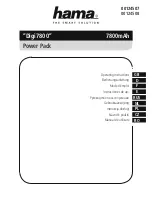
13
OPERATING INSTRUCTIONS
WARNING
• Always wear safety goggles when cleaning tools using compressed air. These materials are
highly abrasive and may accelerate the wear on motor bearings and brushes.
Straight Cutting
A straight cut can be made by clamping a piece of wood or a straight edge to the work piece
and guiding the edge of the saw against it. The straight cut can be also made by using the
edge guide supplied with this tool.
Make the cut from one direction only. Never cut halfway and then complete the cut from the
opposite end.
Metal Cutting
When cutting metal, always clamp down the material. Thin metal should be sandwiched
between two pieces of wood or tightly clamped onto a single piece of wood (with the wood on
top of the metal). Be careful to move the saw slowly. Use lower speeds. Do not twist, bend, or
force the blade.
NOTICE:
It is not recommended that the orbital function be used when cutting metal.
For easier cutting, lubricate the blade with a stick of cutting wax, if available, or use cutting oil
when cutting steel. Never use gasoline!
10. Plunge Cutting
Your jig saw is ideal for plunge cutting directly into
surfaces that cannot be cut from an edge.
WARNING
• Do not plunge cut into metal surfaces.
• Always adjust the base-plate bevel setting to 0°
before making a plunge cut.
a. Firmly clamp the work piece in place.
b. Draw cutting lines for the opening.
c. Hold the saw firmly and tilt it forward so that
the front of the base plate (J) rests on the work
piece.
d. Make sure that the blade (Q) is well clear of the work piece.
e. With the front of the base plate held firmly against the work piece to prevent side wobble,
squeeze the variable-speed trigger switch (B) to start the saw and select the speed, then
gradually lower the blade into the work piece.
f. When the blade touches the work piece, slowly pivot the saw like a hinge until the blade
cuts through the work piece and the shoe plate rests flat on the work piece.
g. Begin sawing in the usual manner along the cut line.
NOTICE:
Always apply a steady, firm, downward pressure on the front of the saw as you cut.
This will keep the saw blade from jumping out of the work piece.
10














































